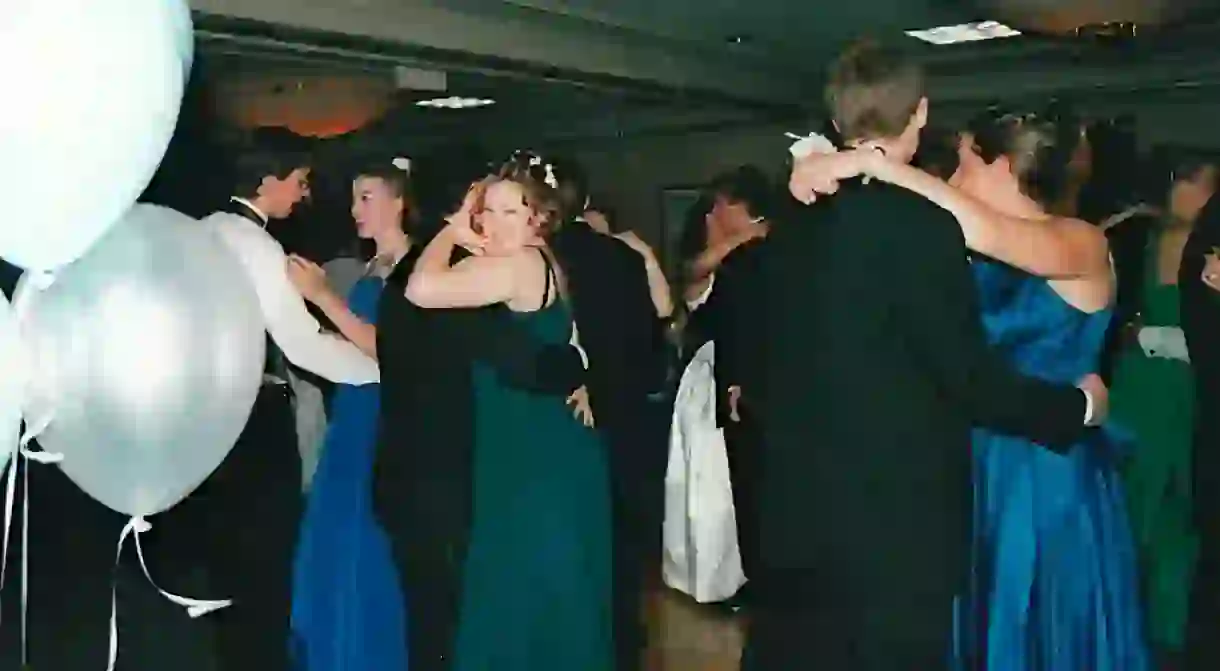Prom in America, an Origin Story

Apple pie, baseball, and—prom? The quintessential rite of spring in America, prom may rank right up at the top of the list of emblems of the U.S. And while prom may conjure up images of limos, corsages, tuxedos, and general debauchery today, the origins of the ultimate high school dance are far humbler, and more chaste.
While proms are more commonly associated with high school today than they are with college, the original proms were banquets held for seniors graduating from university and were co-ed events at what were then single-sex schools. The idea was to foster proper etiquette in the graduating class before they went out into society.
Over the next few decades, many parents and teachers began to think that it might not be a bad idea to initiate a crash course in manners by preparing for a party such as prom at a slightly younger age. And, thus, the dance began its transformation from a collegiate event to a teenage one, and eventually ended up in high school.
The original high school proms were exceptionally innocent affairs—think tea and finger food in a gymnasium, with everyone dressed in their Sunday best. By the 1930s, these dances were widespread in high schools across America, and a nocturnal shift had begun to take place. Proms were now occurring at night, with a dinner before the dance, at which a live band would play.

Prom had become so common that by 1936, a guidebook on how to throw one was published: The Junior-Senior Prom: Complete Practical Suggestions for Staging the Junior-Senior Prom. The book, packed with 99 pages of tips, was perhaps the first indicator of just how elaborate proms were to become.
Much like America itself, prom really blossomed into the force it is today in the 1950s. The booming postwar American economy enabled schools (and parents) to spend more lavishly on proms, and dances that had once taken place in school gyms migrated to country clubs, banquet halls, and hotels. In 1963, President Kennedy actually rescheduled a $1,000-a-head fundraiser at the Beverly Hilton in Los Angeles to accommodate a school that wanted to hold their prom in the space the same evening. However, the ultimate venue may be the one that presidential daughter Susan Ford secured for her high school class in 1975: the White House.
The evolution of the prom dress has mirrored that of the broader fashions of the times. In the 1950s, prom dresses were full-bodied, with long skirts and tight bodices—shoulders sometimes exposed in a slightly more risqué look than that prevalent in the 1940s. As with other dresses, hemlines rose on prom dresses in the 1960s. The hippie aesthetic led some prom-goers in the 1960s and 1970s to radically redefine the notion of formal wear, opting for fringe and beads over lace and tulle. The prom dress really escalated in the blingy 1980s, with sequins, shoulder pads, and ruffles. The ’90s saw a more minimalist look take hold, while the 2000s were all about the Hollywood red carpet-inspired gown. And as for prom attire today? Teenagers tend to dress in whatever style inspires them.

Prom has sometimes served as a site of confrontation and conflict over societal progress. As late at 1994, a principal at an Alabama high school threatened to cancel prom rather than allow interracial couples to attend. The ensuing conflict escalated to the point where the high school was set on fire and burned to the ground. And in 2010, a Mississippi school district decided to cancel its prom rather than allow one female student to attend with her girlfriend. But by and large, proms are a microcosm of an increasingly diverse and tolerant America—which may just be the best and most important crash course in manners any young person can have.













